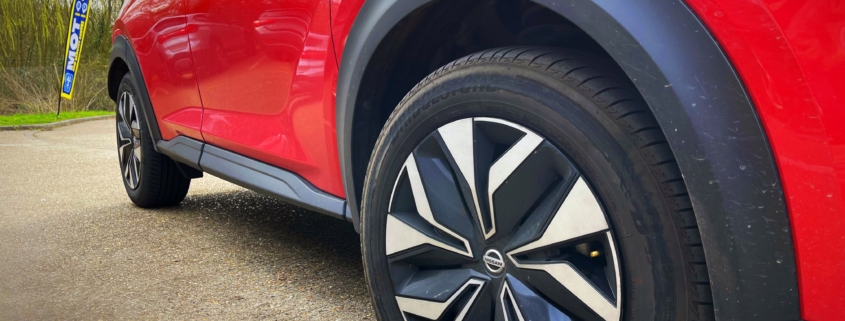Potholes
Potholes
The big, the bad, and the ugly…
There are an estimated one million potholes across the UK, causing breakdowns to rise to a five-year high at a cost to drivers of £474M. So, why do we have so many and how can we avoid any unnecessary motoring costs?
Why do potholes occur?
Potholes are formed by 3 elements: surface cracks, water ingress, and movement. They then expand according to weather conditions and the amount of distress caused over the weakened area.
Surface cracks appear when there is an inadequate road structure. The layers are defined for the applied level of traffic loading allowing the road to flex under defined parameters. However, repeated strain at the bottom of the asphalt can result in the initiation of fatigue cracks which are exacerbated when the defined wheel load is exceeded. Our roads have become busier, so it is no surprise that these loads are regularly surpassed. Other contributory factors are: poor drainage, ageing asphalt, shrinkage, reflective cracking (where a new asphalt covers old), or where utility trenches have been excavated and the disruption of soil creates movement.
Water seeps into the cracks, saturating the asphalt layers and softening the soil below, damaging the infrastructure.
Movement from traffic pounding the road, fractures the surface which continues to expand and deepen contaminating the layers beneath, creating further weakened areas. This is most likely to occur under where wheels regularly travel and usually closest to the kerb where water drains.
Rainfall and freeze/thaw cycles accelerate development, which is why we see an increase of potholes forming
in the winter months.
Why are there so many potholes?
There are several reasons why we are suffering with an increase of potholes across the UK:
- Increased traffic on the road exceeds the original road design
- Global warming means we have more water and freeze/thaw cycles
- Already stretched Council budgets will not stretch to the level of maintenance required to resurface or seal to prevent asphalt deterioration
So, until we can resolve some of the above, potholes are here to stay for a while. But the real reason this is such an emotive subject is the damage and unwanted expense they cause.
What damage do potholes cause?
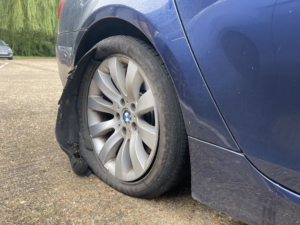
When a tyre hits irregularities in the road, the force exerted on the suspension is directed upwards. The higher up the tire the impact, the more force is pushing the tyre both up and back.
The amount of damage this causes is dependent on how much the tyre can absorb the force of the impact given the tyre size, depth and length of the pothole and speed of travel.
When the tyre cannot absorb the impact, other components are affected. The most common types of damage, other than a damaged tyre or loss of a hubcap are: bent or broken wheel, wheels knocked out of alignment, damaged suspension components, bent steering parts and damaged shock absorbers.
Tyres
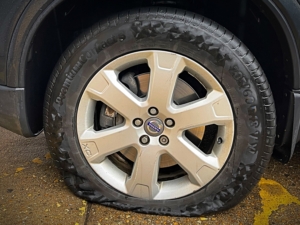
Tyres take the impact first. This can break the interior structure, tear the sidewall, create a bulge or both! If a tyre is under inflated, there is an increased risk of a ‘blow out’. Low-profile tyres can sustain more severe damage.
Wheels
If the tyre does not absorb the impact, the wheel suffers. It could bend, crack, or break as a result. Alloys are fragile and not easily mended, so likely to need replacing if damaged.
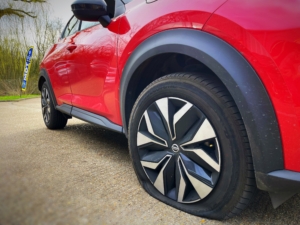
Suspension
When a pothole is hit at force and the impact is upward and rearward, the forces are transmitted to the suspension.
If there is enough force, suspension parts and steering can become damaged, and wheels knocked out of alignment.
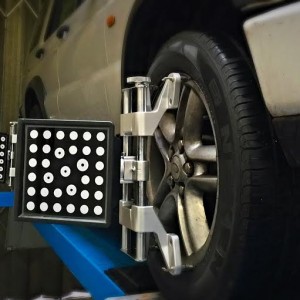 Alignment
Alignment
Alignment should be checked after hitting a pothole or a kerb, to prevent tyres wearing unevenly and prematurely. You’ll also notice the car pulling to one side or driving becoming noticeably uncomfortable.
Shock Absorbers
Shock absorbers rarely break from impact with potholes, more likely they will wear out due to extensive driving on poorly maintained roads.
If there is oil leaking from a shock absorber, it could be that it has reached the end of its useful life. To check them, push down hard two or three times on a corner of the vehicle, then let go when the car is at its lowest point. If the car bounces twice or more, its time to change that shock absorber. Repeat the test on all four corners of the vehicle. Shock absorbers are usually changed in pairs.
If you are in any doubt, don’t leave your safety to chance, get your vehicle checked out by a professional.
What do I do if I hit a pothole?
Check for damage
Damage can happen even at low speeds, so it is always worth checking first.
- Pull over to a safe location as soon as it is safe to do so
- Check your tyre for visible damage such as something stuck in the tyre, slit, puncture or damage
- If that is ok, drive slowly off and check for any vibrations or shaking
- Check if your steering wheel doesn’t centre properly or the car is pulling to one side
If anything is untoward or you don’t feel comfortable, take it to your local garage to get it professionally checked over.
Take notes
It is always worth taking notes at the time of the incident as memory changes over time. Details enable you to report the pothole to the Council to ensure the road is safe for others. You may also need them later as evidence for insurance purposes or a potential pothole claim.
Take photos of the hole if it is safe to do so. Include a point of reference such as a can of drink, etc to give a sense of scale. If you happen to have a tape measure in the car, even better! Make sure you can identify exactly where the hole is including the road name and any landmarks. If there are any witnesses, make sure you have their contact details.
Report the pothole
Councils have a responsibility to fix large potholes if they know about them. Reporting the pothole enables the council to schedule a repair and put preventative measures in place until it is fixed.
Report it to Hertfordshire Highways: https://www.hertfordshire.gov.uk/services/Highways-roads-and-pavements/Report-a-problem/Report-a-street-light-or-pothole.aspx
Repair your car
Make sure you get your car repaired or checked over if you are unsure as to the damage that has been caused. The priority is keeping you and other road users safe.
The garage can check over your tyres, wheels, shock absorbers, suspension and steering to give you the confidence that all is safe or show you what has been damaged and give recommendations on economical and effective repairs.
Once repaired, make sure you keep your garage report establishing the pothole caused the damage, and receipts to support any claims you make to the Council.
Prevention is better than cure!
Judgement errors can be costly, so it is better to avoid potholes if you can.
Think about where you are driving: Small country roads are not as well maintained, and under strain from heavier vehicles (such as tractors, etc), so are more likely to have potholes. Give yourself time to spot them by driving slowly and steadily.
Consider driving conditions: Water not only creates potholes, but also hides road damage when covered by heavy rain! If safe, drive around water to avoid concealed dangers.
Maximise visibility: Subject to weather conditions, potholes are usually easy to spot. Give them as much attention as other hazards. Reduce speed and allow yourself enough time to react to any in your path.
Choose the right Tyre: Tyres are different and invariably you ‘get what you pay for’. Typically, smaller, more flimsy tyres perform less well on uneven road surfaces, whereas bigger, broader tyres are better equipped to manage the challenging terrain. Arguably a quality set of winter or all-season tyres are best, but are not your only choice.
For a full range and good advice on tyre choices talk to your local garage who will be able to provide the best advice.
The way forward…
There has been a lot of publicity recently on the news and a launch of National Pothole Day on the 15 January! Various organisations are supporting the push to get the potholes rectified.
The AA has become a part of the Pothole Partnership and sent a five-point plan to central and local government officials to press the case for more effective road repairs. This includes making permanent repairs rather than using temporary patches, accelerating the distribution of funding and full transparency from local authorities on their progress in tackling backlogs of road repair.
The RAC are also involved in supporting improvements by joining forces with technology company Metricell to encourage drivers to use a mobile app to collect data on road conditions via smartphone cameras.
The government has pledged an extra £8.3 billion of funding over 11 years for local road maintenance.
The Local Government Association are tackling the £14billion backlog of road repairs, including learning from and adopting new innovative techniques.
The Department of Transport launched a consultation to crackdown on utility companies letting roadworks overrun, which will cut congestion and generate additional income to resurface roads and a plan to double fines for those working without a permit.
So, efforts are in place to make our roads safer, but in reality, until the funding converts to action, the potholes are here to stay, at least in the short term.
As much as we can take safe actions to avoid them, it is more than likely that we will all succumb to the annoyance of hitting a pothole at some point. Knowing preventative measures we can take and what to do if you hit a pot hole helps and of course choosing the right tyre to avoid damage to expensive parts is essential. If you are unsure, come and talk to the experts at Redbourn Auto Solutions and we’ll be pleased to help you.
In the meantime, look after yourselves in the winter months and if you need any help, give us a call. We’re happy to help ?

